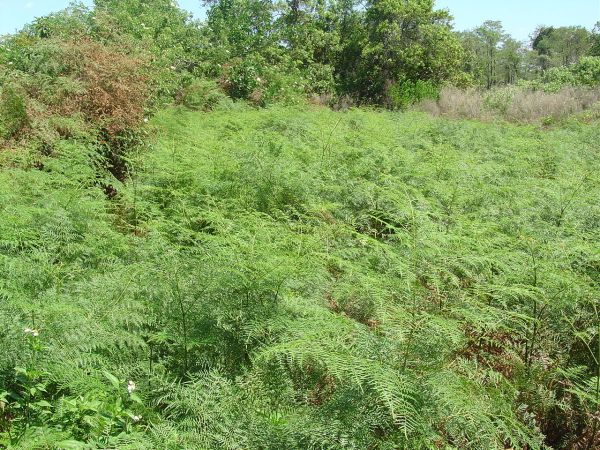Bracken
Pteridium aquilinum (following some taxonomists in interpreting Pteridium as a single species)
Dennstaedtiaceae
My botany class this week gathered fern spores to sow and grow, much fun as well as the perfect Florida-U.K. botanical link I promised our British correspondent Mary Hart in Worcester, England. Can’t think of a tighter intercontinental tie than Bracken Fern, plentiful on our Palm Beach State College campus, and even more-abundant in the U.K., where the fern has become a pest crowding out native wildflowers. The nectary photo below is by Rosemary Winnall who manages a wonderful blog on the ancient Wyre Forest near Worcester. And the bracken-bashing horse is at work thereabouts, in Owsrestry, Shropshire, likewise closeby. That town is the birthplace of beloved WWI poet Wilfred Owen, whose poetic lights came on in childhood in the midst of those pre-bashing brackens according to his brother Harold:
“It was in Broxton among the ferns and bracken and little hills…that the poetry in Wilfred, with gentle pushings, without hurt, began to bud, and not on the battlefields of France.” (Wilfred Owen was shot fatally in France toward the end of the war.)
Now back to Florida. Florida boasts the fern scrambling as high as 21 feet into trees as a vine according to Florida botanist J.K. Small (in 1931). Certain weeds aside, bracken fern is possibly the most widespread vascular plant on Earth, occurring pretty much everywhere from New Zealand to Siberia to Brazil. Ferns do get around, often obscuring their “native origins,” by having dust-sized wind-blown spores which sometimes (including in some brackens) grow into self-fertilizing offspring…the perfect colonizers, especially given the ability of bracken to tolerate extremely broad conditions.
Bracken has some odd features. Ferns usually cluster their spore cases in round, kidney-shaped, or linear clusters called sori (SORE-eye) under the leaves. Try to find these in bracken fern. The spore cases develop just inside the edge of the leaf margin, which curls under hiding them. And who ever heard of a non-flowering plant with a nectary? Young bracken fronds have a nectary near the lowest branch-point on the leaf, probably to feed protective ants.
Any plant as widespread as bracken can be assumed to have loads of roles in historical medicine and other human affairs. True. The plants are high in potash, having made them once useful in glassmaking and soap, not to mention fertilizer. People eat them, but shouldn’t. Bracken toxicity made it all the way to prominence in The Atlantic Magazine CLICK.
But it’s not all about people. Recent studies have highlighted an affinity gorillas have for the fern, as bedding as well as nibbling. If gorillas ever join the ranks of Florida invasive exotic species, they will feel right at home.
————————
Notes: Article on bracken at Owsrestry CLICK
Art by Kevin Hayler CLICK





Mary Hart
September 21, 2013 at 4:50 am
Delighted to get more info on bracken, I’d never heard of eating it before! There is a very interestingarticle on control of P. aquilinum if you look at putting a brake on bracken – university of Liverpool. Ref is http://www.liv.ac.uk/researchintelligence/issue24/brackencontrol.co.uk Another possibility is www. brackencontrol.co. uk. but it’s a bit sketchy!
George Rogers
September 21, 2013 at 8:41 am
Had a little trouble opening the link but got it to work. http://www.liv.ac.uk/researchintelligence/issue24/brackencontrol.html
Why would a fern that has been around forever decide to take over like that? Now my homework is to investigate asulam.